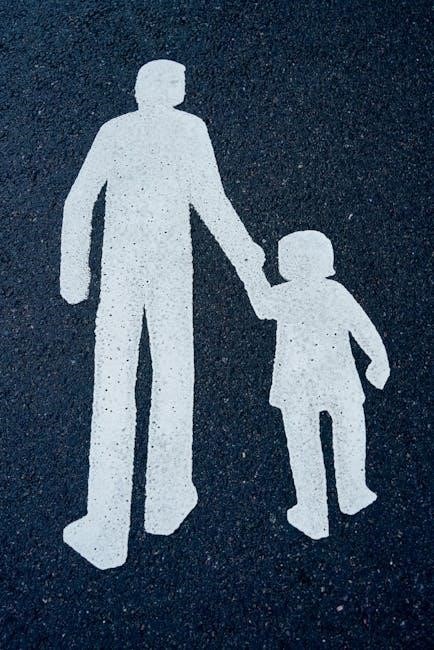Lifeguarding is a vital role ensuring water safety at pools, beaches, and water parks․ Lifeguards prevent accidents, respond to emergencies, and provide first aid․ Parents need a guide to understand water safety basics, choose the right lifeguard courses, and support their children in learning essential skills․ Certification programs like the American Red Cross offer comprehensive training in CPR, surveillance, and rescue techniques, empowering individuals to become certified lifeguards and promote aquatic safety․
1․1 What is a Lifeguard?
A lifeguard is a trained professional responsible for ensuring the safety of individuals in aquatic environments, such as swimming pools, beaches, and water parks․ Their primary role is to prevent accidents, respond to emergencies, and provide assistance when needed․ Lifeguards are skilled in surveillance, rescue operations, and first aid, making them the first line of defense against drowning and injuries․ They must maintain constant vigilance to identify potential hazards and act swiftly in critical situations․ Lifeguards undergo rigorous training, including CPR and water rescue techniques, to perform their duties effectively․ Certification programs, such as those offered by the American Red Cross, equip lifeguards with the necessary skills to protect swimmers and ensure a safe environment for everyone․
1․2 The Importance of Lifeguards in Water Safety
Lifeguards play a crucial role in maintaining water safety by acting as the first line of defense against accidents and emergencies․ Their presence ensures swimmers feel secure, knowing help is immediately available if needed․ Lifeguards are trained to identify potential hazards, prevent incidents, and respond swiftly to emergencies, such as drownings or injuries․ Their ability to provide CPR, first aid, and rescue operations makes them indispensable in aquatic environments․ Parents can trust that lifeguards are vigilant and prepared, creating a safer environment for children to enjoy water activities․ The importance of lifeguards lies in their ability to prevent tragedies and provide peace of mind for families, making their role essential for water safety․
1․3 Why Parents Need a Lifeguard Guide
Parents need a lifeguard guide to ensure their children’s safety in aquatic environments․ Understanding water safety basics, recognizing hazards, and knowing how to respond to emergencies are essential skills․ A guide provides parents with the knowledge to teach their children proper water safety practices, reducing the risk of accidents․ It also helps parents choose the right lifeguard courses for their children, ensuring they receive comprehensive training․ Additionally, a guide offers insights into the challenges lifeguards face, preparing parents to support their children in this critical role․ By equipping parents with this information, a lifeguard guide promotes a safer and more informed approach to water activities for families․

Responsibilities of a Lifeguard
Lifeguards ensure swimmer safety, respond to emergencies, provide first aid and CPR, communicate with swimmers and staff, and prevent accidents and hazards in aquatic environments․
2․1 Ensuring Swimmer Safety

Lifeguards play a crucial role in ensuring swimmer safety by actively monitoring water areas, enforcing safety rules, and being vigilant for signs of distress․ They are trained to identify potential hazards and take proactive measures to prevent accidents․ Lifeguards also educate swimmers and parents about water safety practices, such as swimming in designated areas and avoiding risky behaviors․ By maintaining constant surveillance and responding quickly to emergencies, lifeguards create a secure environment for everyone․ Parents can support these efforts by understanding their own responsibilities, such as supervising children and following safety guidelines․ This collaborative approach ensures a safer and more enjoyable experience for all swimmers․
2․2 Responding to Emergencies
Lifeguards are trained to respond swiftly and effectively in emergency situations, ensuring the safety of swimmers․ Their ability to act quickly and make sound decisions is critical in preventing drowning or injury․ Lifeguards are certified in CPR, first aid, and rescue techniques, enabling them to handle a variety of emergencies, from minor injuries to life-threatening situations․ They use surveillance skills to identify potential dangers early and intervene before incidents escalate․ Effective communication is also key, as lifeguards must alert others and coordinate responses․ Parents can trust that lifeguards are prepared to manage emergencies, providing peace of mind for families enjoying aquatic activities․ Their expertise and readiness are essential for maintaining a safe environment․
2․3 Providing First Aid and CPR
Lifeguards are trained to provide immediate first aid and CPR in emergency situations, ensuring swimmers receive critical care until medical professionals arrive․ They are certified to handle injuries, sudden illnesses, and drowning incidents, using techniques like the Heimlich maneuver for choking victims and splinting for fractures․ Lifeguards also administer CPR to restore blood circulation in cardiac arrest cases, significantly improving survival chances․ Their ability to provide prompt and accurate first aid is vital for preventing further harm and stabilizing conditions․ Parents can trust that lifeguards are equipped to deliver essential medical assistance, giving families peace of mind while enjoying aquatic activities․ These skills are a cornerstone of lifeguard training, emphasizing the importance of certification programs like those offered by the American Red Cross․
2․4 Communicating with Swimmers and Staff
Effective communication is a critical skill for lifeguards, ensuring the safety of swimmers and collaboration with staff․ Lifeguards must clearly convey rules, warnings, and instructions to prevent accidents and maintain order․ They use verbal commands, hand signals, and whistles to communicate quickly and efficiently․ Strong interpersonal skills help lifeguards build trust with swimmers, address concerns, and provide reassurance․ Communication also extends to teamwork, as lifeguards often work in pairs or teams to respond to emergencies․ Clear dialogue ensures coordinated efforts, minimizing response times and enhancing safety․ Parents can rely on lifeguards to communicate proactively, addressing potential hazards and fostering a safe environment for everyone․ This skill is a cornerstone of lifeguard training, emphasizing the importance of both verbal and non-verbal communication in aquatic settings․

2․5 Preventing Accidents and Hazards
Lifeguards play a crucial role in preventing accidents and identifying potential hazards in aquatic environments․ By maintaining constant surveillance, they can spot risks such as slippery surfaces, uneven pool floors, or strong currents․ Lifeguards enforce safety rules, such as no running or diving in shallow areas, to minimize accidents․ They also monitor weather conditions, like lightning, and clear the water if necessary․ Additionally, lifeguards educate swimmers about safe practices, ensuring everyone understands the risks and follows guidelines․ Proactive measures like regular inspections of equipment and surroundings further enhance safety․ By addressing hazards before they escalate, lifeguards create a secure environment for swimmers of all ages, reducing the likelihood of incidents and ensuring a enjoyable experience for everyone․
Essential Skills for Lifeguards
Essential skills for lifeguards include strong swimming abilities, CPR certification, rescue techniques, surveillance, and physical fitness to ensure water safety and effective emergency responses always․
3․1 Strong Swimming Abilities
Strong swimming abilities are fundamental for lifeguards, as they must possess the endurance and speed to respond to emergencies effectively․ Lifeguards need to swim long distances, retrieve swimmers in distress, and return to safety without fatigue․ Proficiency in various strokes, including the freestyle and breaststroke, is essential for efficiency in the water․ Parents should encourage their children to develop these skills through structured swim lessons and regular practice․ Lifeguard training programs, such as those offered by the American Red Cross, emphasize swimming competence as a critical component of certification․ By fostering strong swimming abilities, parents help their children build a solid foundation for lifeguarding and water safety․
3․2 CPR and First Aid Certification
CPR and First Aid certification are crucial for lifeguards, enabling them to respond to medical emergencies effectively․ These certifications teach lifeguards how to perform cardiopulmonary resuscitation, use automated external defibrillators (AEDs), and administer first aid for injuries․ The American Red Cross and other organizations offer comprehensive training programs that include hands-on practice and scenario-based learning․ Parents should ensure their children complete these certifications as part of their lifeguard training․ Certification typically includes both online and in-person components, with renewal required every two years to stay updated on the latest techniques; Having these skills not only enhances a lifeguard’s ability to save lives but also builds confidence in handling emergencies․ Proper certification ensures lifeguards are well-prepared to provide critical care when needed․
3․3 Rescue and Emergency Response Techniques
Rescue and emergency response techniques are essential skills for lifeguards, enabling them to act swiftly and effectively in critical situations․ These techniques include water rescues, spinal injury management, and emergency evacuation procedures․ Lifeguards are trained to assess situations, prioritize actions, and use equipment like rescue tubes and first aid kits․ Certification programs, such as those offered by the American Red Cross, emphasize hands-on practice and real-life scenario training․ Parents should ensure their children master these techniques to confidently handle emergencies․ Proper training ensures lifeguards can respond to drowning incidents, injuries, and other aquatic emergencies with precision and care, ultimately saving lives and preventing further harm․

3;4 Surveillance and Observation Skills
Surveillance and observation skills are critical for lifeguards to ensure water safety․ These skills involve constantly scanning the water, identifying potential hazards, and recognizing signs of distress․ Lifeguards are trained to maintain focus, detect subtle changes in swimmers’ behavior, and respond quickly to emergencies․ Effective surveillance requires knowledge of scanning techniques, understanding swimmer body language, and staying alert for hazards like strong currents or slippery surfaces․ Certification programs emphasize these skills, teaching lifeguards to prioritize areas of high risk and communicate effectively with swimmers and staff․ Strong observational abilities enable lifeguards to prevent accidents before they escalate, making them indispensable in aquatic environments․ Continuous practice and training refine these skills, ensuring lifeguards remain vigilant and proactive in safeguarding lives․

3․5 Physical Fitness and Endurance
Physical fitness and endurance are essential for lifeguards to perform their duties effectively․ Lifeguards must possess strong swimming abilities, stamina, and overall physical strength to handle emergencies and prolonged periods of surveillance․ Regular exercise, including cardiovascular training and strength-building activities, is crucial to maintain the energy levels required for rescues and long shifts․ Certification programs like the American Red Cross emphasize the importance of physical conditioning to ensure lifeguards can respond swiftly and efficiently․ Proper nutrition and consistent training help lifeguards build and sustain the endurance needed to protect swimmers and respond to emergencies without fatigue․ This physical preparedness is vital for saving lives and maintaining water safety․
Lifeguard Certification and Training

Lifeguard certification programs, like the American Red Cross, provide comprehensive training in CPR, first aid, surveillance, and rescue techniques․ These courses are essential for water safety and open career opportunities․
4․1 Overview of Certification Programs
Lifeguard certification programs provide comprehensive training in water safety, rescue techniques, and emergency response․ These programs, such as those offered by the American Red Cross, include CPR, first aid, and surveillance skills․ They are designed to equip individuals with the knowledge and abilities to prevent accidents and respond effectively in aquatic environments․ Certification typically involves both theoretical and practical training, ensuring lifeguards are prepared for real-world scenarios․ Many programs offer flexible learning options, such as blended learning, allowing participants to complete coursework at their own pace․ Upon successful completion, lifeguards receive certification valid for two years, with renewal options to maintain their credentials․ These programs are essential for ensuring safety in pools, beaches, and water parks․
4․2 American Red Cross Lifeguard Training
The American Red Cross Lifeguard Training is a renowned program that equips individuals with essential water safety skills․ It includes certification in First Aid, CPR, and AED, ensuring lifeguards are prepared for emergencies․ The program features a blended learning format, combining online coursework with in-person training, allowing participants to learn at their own pace․ Key components include patron surveillance, water rescue techniques, and effective communication․ Upon completion, lifeguards receive a two-year certification, valid across the U․S․ This comprehensive training is designed to empower lifeguards with the confidence and expertise to respond to emergencies, prevent accidents, and ensure a safe environment for swimmers of all ages․
4․3 Certification Benefits and Requirements
Obtaining a lifeguard certification offers numerous benefits, including enhanced water safety skills, career opportunities, and the ability to protect others․ Certification requirements typically include completing a training program, passing a written exam, and demonstrating proficiency in rescue techniques․ Many programs, like the American Red Cross, require candidates to be at least 15 years old and possess strong swimming abilities․ Certification is valid for two years, after which renewal is necessary․ Parents can encourage their children to pursue certification, ensuring they gain essential life-saving skills․ The process also fosters physical fitness, teamwork, and responsibility․ By meeting these requirements, individuals become qualified to work in aquatic environments, providing a safe experience for swimmers and building a rewarding career in lifeguarding․
4․4 Maintaining Certification Through Renewals
Maintaining lifeguard certification requires periodic renewals to ensure skills remain current and effective․ Most certifications, such as those from the American Red Cross, expire after two years․ Renewal typically involves completing continuing education courses and passing practical assessments․ Parents can support their children by encouraging timely renewals, as this ensures their lifeguarding skills stay sharp․ Many programs offer renewal courses online or in person, making it convenient to stay certified․ Regular renewal also keeps lifeguards updated on the latest water safety protocols and emergency response techniques․ By prioritizing certification maintenance, lifeguards can continue to provide reliable protection and care in aquatic environments, ensuring a safe experience for everyone․
Parental Involvement in Water Safety
Parents play a crucial role in water safety by teaching children basic skills, supervising pool time, and supporting lifeguard training․ Their involvement ensures a safer aquatic environment․
5․1 Teaching Children Water Safety Basics
Teaching children water safety basics is essential for preventing accidents and ensuring their confidence in aquatic environments․ Parents should start by educating kids on proper entry and exit techniques for pools, understanding water depth, and the importance of swimming in designated areas․ Supervision is key; adults must always be present when children are near water․ Simple rules, like no running near pools and no swimming alone, can significantly reduce risks․ Additionally, parents can introduce basic floating and treading water skills, laying the foundation for formal swimming lessons․ By fostering a respect for water and promoting safe practices, parents can help their children enjoy water activities safely and responsibly․
5․2 Choosing the Right Lifeguard Course
Choosing the right lifeguard course is crucial for ensuring effective water safety training․ Parents should look for programs certified by reputable organizations, such as the American Red Cross or American Lifeguard Association․ These courses typically include CPR/AED training, first aid, and water rescue techniques․ Consider the age and skill level of the participant, as some programs are designed for youth or specific aquatic environments․ Instructor experience and hands-on training opportunities are also important factors․ Online blended learning options can offer flexibility, but ensure they include in-person skills practice․ Certification should be widely recognized and valid for at least two years․ By selecting a comprehensive and accredited program, parents can ensure their children receive the best preparation for lifeguarding responsibilities and water safety․
5․3 Understanding Lifeguard Challenges
Understanding the challenges lifeguards face is essential for parents to appreciate the demands of the role․ Lifeguards must remain vigilant, scanning their surroundings constantly to prevent accidents․ They often work in harsh weather conditions, such as intense sun or cold, which can be physically exhausting․ Quick decision-making is critical in emergencies, requiring both physical and mental stamina․ Lifeguards must also handle multiple responsibilities, including surveillance, communication, and providing first aid․ Additionally, they may encounter difficult situations, such as uncooperative swimmers or high-stress emergencies, which can be emotionally taxing․ Parents should encourage their children to stay focused, maintain physical fitness, and develop strong communication skills to meet these challenges effectively․

The Future of Lifeguarding
The future of lifeguarding involves advanced technologies like AI surveillance systems and improved training methods․ Certification programs will evolve, offering specialized skills and broader career opportunities globally․

6․1 Technological Advancements in Lifeguarding
Technological advancements are revolutionizing lifeguarding, enhancing water safety and emergency response․ AI-powered surveillance systems now monitor swimming areas, detecting distress faster than human eyes․ Drones equipped with cameras patrol large water bodies, providing real-time monitoring and rapid response capabilities․ Smart goggles with built-in sensors help lifeguards track swimmers’ vital signs, preventing emergencies․ Automated detection systems alert lifeguards to potential drownings, reducing reaction times․ These innovations, combined with traditional training, create a safer environment for swimmers․ Parents can feel more confident knowing advanced technologies support lifeguards in protecting their children․ As technology evolves, lifeguarding becomes more efficient and effective, ensuring better outcomes in water safety․
6․2 Emerging Trends in Water Safety
Emerging trends in water safety emphasize proactive measures to prevent accidents and enhance lifeguard effectiveness․ Community-wide awareness campaigns are gaining traction, educating parents and children about drowning prevention․ Advanced water safety education programs are being integrated into schools, teaching basic swimming skills and emergency response․ The development of wearable safety devices, such as smart wristbands that alert lifeguards, is becoming more prevalent․ Additionally, there is a growing focus on inclusive water safety initiatives, ensuring accessibility for individuals with disabilities․ Parents are also benefiting from online resources and apps that provide water safety tips and emergency response guides․ These trends reflect a shift toward a more holistic approach to water safety, empowering both lifeguards and parents to create safer aquatic environments․

6․3 Career Opportunities for Lifeguards
Becoming a certified lifeguard opens the door to a rewarding and versatile career in water safety․ Lifeguards can work in various settings, including swimming pools, beaches, water parks, and youth camps․ The demand for skilled lifeguards is high, both domestically and internationally, making it a career with global opportunities․ Certification programs, such as those offered by the American Red Cross, equip individuals with essential skills in CPR, first aid, and emergency response, enhancing employability․ Lifeguarding also serves as a foundation for advanced roles, such as water safety instructors or aquatic facility managers․ For parents, encouraging their children to pursue lifeguard certification can lead to a fulfilling career that combines personal growth with community service, ensuring safer aquatic environments worldwide;
In conclusion, lifeguarding is a critical profession that ensures water safety and prevents accidents in aquatic environments․ Parents play a vital role in promoting water safety by teaching their children essential skills and supporting their involvement in lifeguard training․ Certification programs, such as those offered by the American Red Cross, provide comprehensive training in CPR, first aid, and emergency response, empowering individuals to become skilled lifeguards․ By encouraging their children to pursue lifeguard certification, parents contribute to safer communities and open doors to rewarding career opportunities․ The future of lifeguarding is bright, with advancements in technology and training methods continuing to enhance water safety worldwide․
